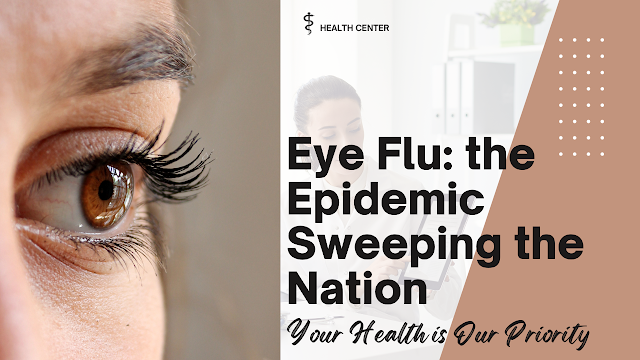Understanding Eye Flu
Eye flu, also known as
conjunctivitis, is an inflammation of the conjunctiva, the thin membrane that
covers the white part of the eyeball and the inner surface of the eyelids. It
is commonly caused by infections, allergies, or exposure to irritants.
Causes and Transmission
Eye flu can be caused by viral or
bacterial infections, allergies, or exposure to irritants such as chemicals. It
can be transmitted through direct contact with infected individuals, sharing
contaminated objects, or exposure to respiratory droplets in the air.
Common Symptoms
Symptoms of eye flu may include
redness, itching, burning sensation, discharge from the eyes, excessive
tearing, swollen eyelids, and sensitivity to light. In some cases, individuals
may experience blurred vision or a feeling of grittiness in the eyes.
Types of Eye Flu
Viral Eye Flu
- Characteristics and Symptoms
Viral eye flu is the most common
type and is usually caused by adenoviruses. It is highly contagious and can
spread rapidly in crowded places. Symptoms may include redness, watery
discharge, foreign body sensation, and sensitivity to light.
- Treatment Options
There is no specific cure for viral
eye flu. Treatment focuses on relieving symptoms and preventing the spread of
infection. It may include lubricating eye drops, cold compresses, and good
hygiene practices.
Bacterial Eye Flu
- Characteristics and Symptoms
Bacterial eye flu is caused by
bacteria such as Staphylococcus or Streptococcus. It often leads to more severe
symptoms compared to viral eye flu, including pus-like discharge, sticky
eyelids, and a gritty sensation in the eyes.
- Treatment Options
Bacterial eye flu is typically
treated with antibiotic eye drops or ointments prescribed by a healthcare
professional. It is important to follow the complete course of antibiotics to
prevent recurrence and potential complications.
Allergic Conjunctivitis
- Characteristics and Symptoms
Allergic conjunctivitis is a
non-infectious form of eye flu caused by allergens such as pollen, dust mites,
or pet dander. It is often associated with other allergic conditions, such as
hay fever. Symptoms may include itching, redness, tearing, and swelling of the
conjunctiva.
- Treatment Options
Treatment for allergic
conjunctivitis may involve avoiding known allergens, using over-the-counter
antihistamine eye drops, or seeking prescription medications from an eye
specialist, such as mast cell stabilizers or corticosteroids.
Other Forms of Eye Flu
- Chemical Conjunctivitis
Chemical conjunctivitis can occur
when the eyes are exposed to irritating substances, such as cleaning agents or
pollutants. Symptoms may include redness, burning, and excessive tearing.
Prompt rinsing of the eyes with clean water is essential to minimize damage and
seek medical attention if symptoms persist.
- Contact Lens-Related Conjunctivitis
Contact lens-related conjunctivitis
can occur due to poor lens hygiene, improper lens care, or prolonged lens wear.
Symptoms may include redness, discomfort, blurry vision, or increased lens
intolerance. Proper cleaning and maintenance of contact lenses, as well as
regular eye check-ups, are important to prevent and manage this form of eye
flu.
Diagnosis and Prevention
Early recognition and proper
diagnosis of eye flu are crucial. Individuals who experience persistent eye
redness, discomfort, or changes in vision should seek medical attention
promptly to determine the underlying cause and receive appropriate treatment.
Diagnostic Procedures
- Laboratory Tests
In some cases, healthcare
professionals may perform laboratory tests on eye discharge samples to identify
the specific cause of eye flu, especially in cases where the infection may be
bacterial or when the underlying cause is unclear.
- Physical Examination by an Eye Specialist
An eye specialist may conduct a
comprehensive eye examination, including assessing the severity of symptoms,
checking the visual acuity, and examining the conjunctiva and eyelids for signs
of inflammation or infection.
Prevention Strategies
- Hygiene Practices
Practicing good hygiene is essential
in preventing the spread of eye flu. This includes frequently washing hands
with soap and water, avoiding touching the eyes with unwashed hands, and using
clean towels and tissues.
- Avoiding Contaminated Objects
Avoid sharing personal items such as
towels, tissues, or makeup brushes, as they can harbor infectious agents that
may cause eye flu. It is also important to regularly clean and disinfect
contact lenses and their storage cases, following proper hygiene guidelines.
Treating Eye Flu
Home Remedies and Self-Care
- Applying warm compresses may help relieve discomfort
and reduce eyelid swelling.
- Avoiding rubbing or touching the eyes to prevent
further irritation or spreading the infection.
- Using artificial tears or lubricating eye drops can
help alleviate dryness and provide temporary relief from symptoms.
Over-the-Counter Medications
Over-the-counter antihistamine eye
drops or decongestants can often provide relief from the symptoms of allergic
conjunctivitis. However, it is essential to read and follow the instructions
carefully and consult a healthcare professional if symptoms worsen or persist.
Prescription Medications
For severe or persistent cases of
eye flu, a healthcare professional may prescribe specific medications, such as
antibiotic eye drops or ointments for bacterial eye flu, or
prescription-strength antihistamine eye drops or corticosteroids for allergic
conjunctivitis.
Treating Complications
In some instances, eye flu may lead
to complications such as corneal ulcers, which require immediate medical
attention. Additional treatment options may include medication for pain management,
anti-inflammatory drugs, or specialized interventions based on the severity of
the complications.
Special Considerations for Specific Demographics
Eye Flu in Children
Children are prone to eye flu due to
their higher likelihood of coming into contact with infectious agents. It is
important to teach them proper hygiene practices, including washing hands
frequently, not sharing personal items, and avoiding touching their eyes to
minimize the risk of eye flu.
Eye Flu During Pregnancy
Pregnant individuals should be
cautious when dealing with eye flu as some medications may not be suitable
during pregnancy. It is crucial to consult with a healthcare professional to
determine the safest and most effective treatment options.
Eye Flu in Older Adults
Older adults may experience more
severe symptoms and complications due to age-related changes in the immune
system and pre-existing underlying health conditions. Regular eye exams,
immediate medical attention for symptoms, and adherence to treatment are
crucial to manage eye flu effectively.
Complications and Severity
Potential Complications of Untreated Eye Flu
If left untreated, eye flu can lead
to complications such as corneal ulcers, which may result in permanent vision
loss or scarring. Prompt diagnosis and appropriate treatment are essential to
prevent these complications and maintain healthy eyesight.
Long-Term Effects on Vision
While most cases of eye flu resolve
without long-term effects, certain types or severe cases can potentially cause
damage to the cornea or other structures of the eye, leading to visual
impairments or decreased vision. Close monitoring and proper management are
necessary to prevent long-term vision problems.
Coping with Eye Flu
Managing Discomfort and Pain
Applying cold compresses or warm
compresses as per healthcare professional's recommendations can help alleviate
discomfort and reduce eye inflammation and pain. Over-the-counter pain
relievers may also provide temporary relief.
Dealing with Photosensitivity
Individuals experiencing eye flu may
become more sensitive to bright lights or sunlight. Wearing sunglasses or
avoiding excessive exposure to harsh lighting conditions can help alleviate
discomfort and reduce photosensitivity symptoms.
Psychological Aspects and Support
Eye flu can be distressing and
affect one's quality of life. It is important to seek emotional support from
loved ones or consider professional counseling to cope with the stress and
anxiety associated with the condition.
Eye Flu Season and Outbreaks
Eye Flu Patterns and Seasonal Variations
Eye flu tends to have seasonal
patterns, with outbreaks more commonly occurring in spring and fall. However,
it can still occur at any time of the year. Increased awareness during peak
seasons and adherence to preventive strategies can help minimize the impact of
eye flu outbreaks.
Strategies to Cope with Outbreaks
During eye flu outbreaks or in high-risk environments, maintaining strict hygiene practices, such as frequent handwashing, disinfection of commonly touched surfaces, and avoiding crowded areas, can greatly reduce the risk of transmission and help contain the spread of the infection.
Eye Flu Myths and Misconceptions
Addressing Common Misunderstandings
- Eye flu is not solely caused by cold weather or
exposure to rain.
- Eye flu cannot be cured by simply rinsing the eyes with
water.
- Antibiotics are only effective for bacterial eye flu
and not for viral or allergic forms.
- Eye flu is not caused by looking at screens or reading
in low light conditions.
Dispelling Popular Myths
- Myth: Eye flu is always highly contagious.
- Fact: While viral and bacterial eye flu can be
contagious, allergic conjunctivitis is not.
- Myth: Eye flu is only caused by infections.
- Fact: Eye flu can also result from allergies or
exposure to irritants.
Eye Flu and Occupational Hazards
Eye Flu Risks in Certain Occupations
Occupations that involve frequent
exposure to irritants, chemicals, or infectious agents may increase the risk of
eye flu. This includes healthcare professionals, laboratory workers, janitorial
staff, and individuals working in environments with a high prevalence of
allergens.
Preventive Measures at the Workplace
Employers should ensure proper training, education, and use of personal protective equipment (PPE) for employees at risk of eye flu. This may include providing safety goggles, implementing hygiene protocols, and promoting regular eye check-ups.
Establishing Public Awareness Campaigns
Importance of Education and Awareness
Public awareness campaigns play a
vital role in preventing and managing eye flu. These initiatives can educate
the general population about the causes, transmission, symptoms, preventive
measures, and available treatments for eye flu, thereby reducing the overall
burden of the disease.
Role of Healthcare Professionals and Organizations
Healthcare professionals and
organizations have a responsibility to disseminate accurate information about
eye flu. By collaborating with schools, workplaces, and community centers, they
can contribute to creating effective awareness campaigns and promoting good eye
health practices.
Eye Flu Prevention in Schools and Public Settings
Strategies for Preventing Eye Flu Transmission in Schools
- Promoting hand hygiene practices among students and
staff.
- Educating students about proper use and care of
personal items.
- Encouraging students to avoid touching their eyes and
sharing items that come into contact with the eyes.
Promoting Hygiene Practices in Public Places
- Providing access to hand hygiene facilities, such as
hand sanitizers or washbasins, in public settings.
- Displaying educational materials about eye flu
transmission and prevention.
- Regularly cleaning and disinfecting commonly touched
surfaces to reduce the risk of contamination.
Eye Flu and Personal Protective Equipment (PPE)
Use of Eye Protection in High-Risk Environments
In high-risk environments where
exposure to infectious agents or irritating substances is common, the use of
protective eyewear, such as safety goggles or face shields, can significantly reduce
the risk of eye flu transmission and protect the eyes from potential harm.
Importance of PPE in Healthcare Settings
Healthcare professionals should
adhere to proper PPE protocols, including wearing gloves, masks, and eye
protection, when treating patients with eye flu or working in environments
where the risk of transmission is elevated. This can safeguard both the
healthcare workers and the patients.
Research and Advancements in Eye Flu Treatment
Ongoing Research Efforts
Researchers continue to explore new
treatment modalities, including antiviral therapies and targeted
immunomodulatory approaches, to improve the management of viral eye flu.
Ongoing studies aim to identify more effective and safe treatment options.
New Treatment Options on the Horizon
Advancements in drug delivery systems, such as sustained-release implants or nanoparticle-based formulations, show promise in enhancing the efficacy and convenience of eye flu treatments. These developments may offer more efficient and patient-friendly treatment options in the future.
FAQs (Frequently Asked Questions)
What is Eye Flu?
Eye flu, also known as
conjunctivitis, is an inflammation of the conjunctiva, the thin membrane
covering the white part of the eye and the inner surface of the eyelids. It can
be caused by viral or bacterial infections, allergies, or exposure to
irritants.
How is Eye Flu Transmitted?
Eye flu can be transmitted through
direct contact with infected individuals, sharing contaminated objects, or
exposure to respiratory droplets in the air.
Can Eye Flu Cause Permanent Vision Loss?
In rare cases, untreated or severe
eye flu can lead to complications such as corneal ulcers, which may result in
permanent vision loss or scarring. Prompt diagnosis and appropriate treatment
are crucial to prevent these complications.
Is Eye Flu More Common in Certain Seasons?
Eye flu may have seasonal patterns,
with increased occurrences during spring and fall. However, it can still occur
at any time of the year.
Can Wearing Glasses Protect Against Eye Flu?
Wearing glasses alone cannot provide
complete protection against eye flu. However, glasses may act as a barrier to
prevent direct contact between the eyes and potential infectious agents.
How Long Does Eye Flu Typically Last?
The duration of eye flu can vary
depending on the underlying cause and individual factors. Most cases of viral
eye flu resolve within one to two weeks, while bacterial or allergic forms may
require specific treatment and take longer to clear.
Is Eye Flu Contagious?
Viral and bacterial forms of eye flu
are contagious and can be easily transmitted through direct contact or sharing
contaminated objects. Allergic conjunctivitis, however, is not contagious.
Conclusion
Eye flu, or conjunctivitis, is a
common condition that affects people of all ages. Understanding the different
types of eye flu, their symptoms, and treatment options is crucial in managing
the condition effectively. By practicing good hygiene, seeking timely medical
attention, and promoting public awareness, we can unmask the silent epidemic
sweeping the nation and ensure better eye health for everyone.











If you have any doubt, let me know.